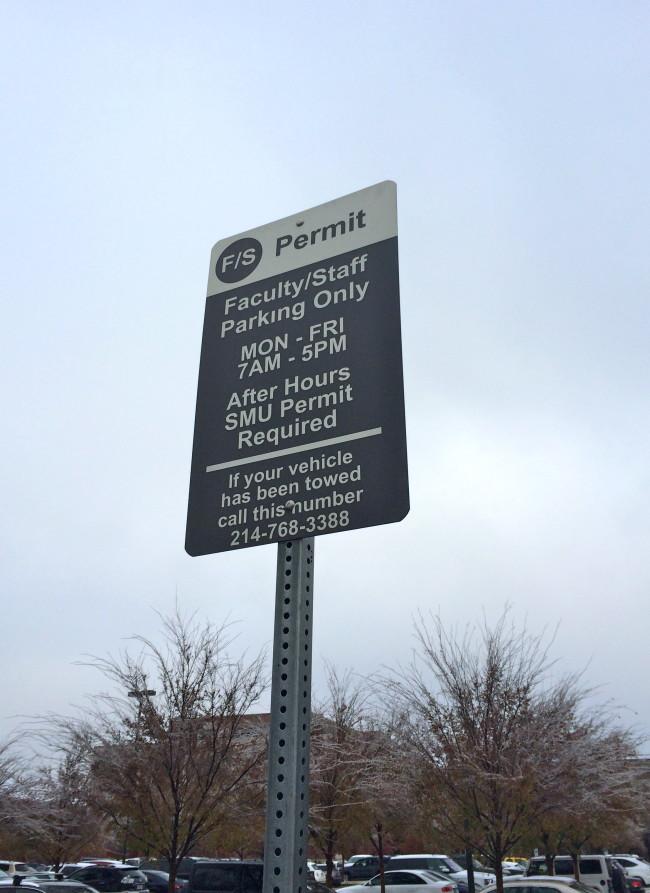
Within the next few years, SMU’s campus will see a complete transformation and redesign. Not only will 1/3 of students live on campus with the new Residential Commons, but there will also be more pedestrian walkways and gardens, and fewer parking lots.
While the majority of these changes will be made to beautify and improve the campus, students and faculty have one common question: “Where are we going to park?”
Student Senate, along with SMU Parking Services, has created a “Parking Task Force” compromised of senators passionate about parking issues on campus to answer these questions.
“Virtually, we’re losing every on-campus parking lot that isn’t a garage in the next five to 10 years,” said Dedman Senator Zane Cavender at the Nov. 19 Student Senate meeting.
The majority of campus parking will be on the exterior of campus, as to promote the new pedestrian walkways and a motor-free campus.
According to Cavender, a motor-free campus would encourage students to come to campus, stay, and not be worried about where they are parked or how quickly they can get to their car.
“Getting students to stay on campus, be involved on campus and enjoy their time on campus doesn’t necessitate the use of a vehicle to collect dust in a parking garage six days out of the week,” he said.
SMU’s director of parking and ID services, Mark Rhodes, works with the Task Force as a liaison between the students and the administration.
“I am a resource to the Senators,” Rhodes said. “I don’t want to bias the process. I want them to think creatively.”
Cavender believes that the university will be most open to suggestions from students that limit the amount of vehicles on campus.
Students will see a few notable changes for the short term, including parking counts on the outside of Binkley Garage, Moody Garage and the new Residential Commons Garage. The counts, operated by a software program, will alert drivers how many cars are currently parked in the garage.
Other short-term changes suggested by the Task Force include altering the class schedule, so that the majority of classes do not all fall between 10 a.m. and 2 p.m., and limited parking for first and second-year students.
According to Rhodes, if these changes will go into effect by the next academic year, they need to move “nimble and quick.”
“This is the hard part. Ideally, some lower-level parking changes would be implemented as early as next semester. Realistically, the larger goals can take five to 10 years,” Cavender said.
Many SMU students and faculty say they are concerned that the new parking goals offer extremely limited options for convenient and quick on-campus parking.
“It’s hard enough right now to find parking in any garage and usually the spot I find is far away from where my class actually is. I’ve started parking in the metered spots near Hughes-Trigg recently so I don’t waste 30 minutes of my day searching for a spot,” junior Alex Novak said.
The Task Force agrees that parking should not be an issue in getting students to class.
“When students skip or miss class due to the lack of parking on campus, academics begin to suffer, and it’s a nasty domino effect from there,” Cavender said.
Some students believe the parking changes won’t make too much of a difference.
“There is barely any parking on campus for students now. It is already designated for a certain group of people, which rarely includes students. Hopefully, though, that will minimize the amount of parking tickets students get,” sophomore Maggie MacConnell said.
Marci Armstrong, an associate dean in the Cox School of Business, is “all for” the pedestrian walkways.
“Our campus is absolutely lovely and I look forward to enjoying it even more without having to look out for cars,” she said.
Yolette Garcia, assistant dean of the Annette Caldwell Simmons School of Education and Human Development, also isn’t bothered by the new plans.
“To me, it makes no difference where I park,” she said.
Currently, students who park on campus pay a fee for either residential or commuter parking. These permits allow SMU students to park in most on-campus parking lots, as long as their parking permits are displayed on the lower right hand side of their front windshield. Students are permitted to park in any AUR or S parking lots, or R if they are residents. Full school year parking permits cost students $280, while part time permits cost $145.
Faculty members parking on university property must also have a parking pass on their lower right hand windshield. They are permitted to park in any F or S lots.
Students who have any comments, concerns or suggestions are encouraged to email Cavender at zcavender@smu.edu.
“With student input, communication and engagement, we will be able to make positive changes to our campus parking situation. Without a large and loud student voice, many of these potential improvements might not gain traction,” Cavender said.








